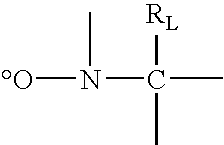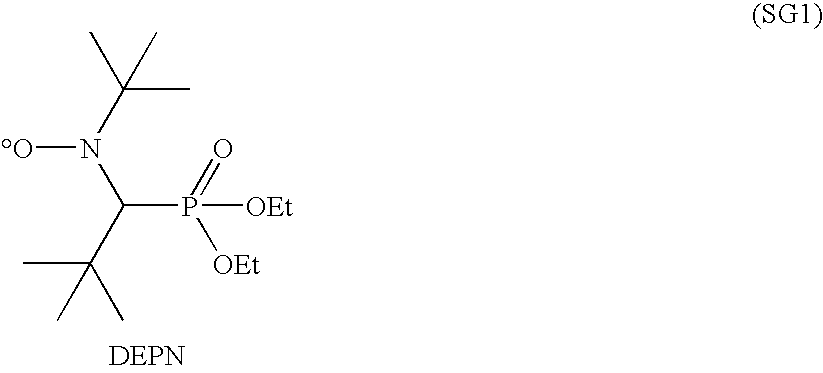Low Surface Energy Block Copolymer Preparation Methods and Applications
a technology of low surface energy and copolymer, applied in the field of block copolymer preparation, can solve the problems of difficult to achieve the desired surface and bulk properties using a single polymer, require extensive processing, and difficult to control the composition and molecular weight distribution of the co-polymer
- Summary
- Abstract
- Description
- Claims
- Application Information
AI Technical Summary
Benefits of technology
Problems solved by technology
Method used
Image
Examples
example 1
[0066]This example illustrates preparation of a fluorinated polymer. Because the polymer has a nitroxide end group, it can function as a macroinitiator of free radical polymerization.
[0067]ZONYL® TA-N (160.587 g, 297 mmol) was added to a 100 ml jacketed glass reactor and heated with stirring under a nitrogen atmosphere to 55° C., where it became liquid. iBA-DEPN (11.348 g, 29.7 mmol) was added, and the reaction mixture heated at 110° C. for 3 hr. Gas chromatography showed the monomer conversion to be 90%. The reaction mixture, containing polymer and residual monomer, vias a solid wax with a melting point of >90° C. Molecular weight by conversion and monomer to initiator ratio was estimated to be 4.7 kg / mol. The polydispersity was estimated to be 1.1-1.2.
example 2
[0068]This example illustrates preparation of an A-B diblock co-polymer starting from a fluorinated macroinitiator.
[0069]To 100 g of the macroinitiator formed in Example 1 was added 81.65 g of butyl acrylate. A strong exotherm was noted at 110° C. The reaction was stopped after 1 hr. The conversion of butyl acrylate, measured by gas chromatography, was 65%.
example 3
[0070]This examples illustrates preparation of an A-B diblock co-polymer starting from a fluorinated macroinitiator followed by a residual monomer chase.
[0071]A mixture of 40.475 g ethyl 3-ethoxy propionate, 32.293 g of methyl methacrylate, and 27.593 g of butyl acrylate was bubbled with nitrogen for 10 min and added to 12.142 g of the macroinitiator formed in Example 1. The reaction mixture was heated 110° C. for 2 hr. Conversion was 82% of the methyl methacrylate and 53% of the butyl acrylate. To remove the residual monomers, LUPEROX® 575 and 30 g of ethyl 3-ethoxy propionate were added and the reaction mixture heated at 110° C. for 1 hr.
PUM
| Property | Measurement | Unit |
|---|---|---|
| polydispersity | aaaaa | aaaaa |
| surface energy | aaaaa | aaaaa |
| molar mass | aaaaa | aaaaa |
Abstract
Description
Claims
Application Information
 Login to View More
Login to View More - R&D
- Intellectual Property
- Life Sciences
- Materials
- Tech Scout
- Unparalleled Data Quality
- Higher Quality Content
- 60% Fewer Hallucinations
Browse by: Latest US Patents, China's latest patents, Technical Efficacy Thesaurus, Application Domain, Technology Topic, Popular Technical Reports.
© 2025 PatSnap. All rights reserved.Legal|Privacy policy|Modern Slavery Act Transparency Statement|Sitemap|About US| Contact US: help@patsnap.com



